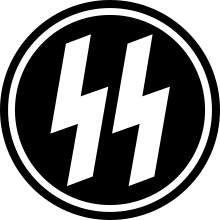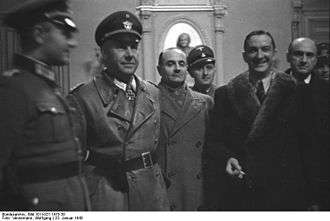Sicherheitspolizei
| Sicherheitspolizei | |
 | |
 SiPo officers in Marseilles during World War II | |
| Agency overview | |
|---|---|
| Formed | 26 June 1936 |
| Preceding agency | |
| Dissolved | 22 September 1939 |
| Superseding agency |
|
| Type | State Security Police |
| Jurisdiction |
Occupied Europe |
| Headquarters | Prinz-Albrecht-Straße, Berlin |
| Employees | 4,500[1] |
| Ministers responsible |
|
| Agency executive |
|
The Sicherheitspolizei (English: Security Police), often abbreviated as SiPo, was a term used in Germany for security police. In the Nazi era, it was used to describe the state political and criminal investigation security agencies. It was made up by the combined forces of the Gestapo (secret state police) and the Kriminalpolizei (criminal police; Kripo) between 1936 and 1939. As a formal agency, the SiPo was folded into the RSHA in 1939, but the term continued to be used informally until the end of World War II in Europe.
Origins
The term originated in August 1919 when the Reichswehr set up the Sicherheitswehr as a militarised police force to take action during times of riots or strikes. However owing to limitations in army numbers, it was renamed the Sicherheitspolizei to avoid attention. They wore a green uniform, and were sometimes called the "Green Police". It was a military body, recruiting largely from the Freikorps, with NCOs and officers from the old German Imperial Army.[2]
Nazi Era
When the Nazis came to national power, Germany, as a federal state, had myriad local and centralised police agencies, which often were un-coordinated and had overlapping jurisdictions. Himmler and Heydrich's grand plan was to fully absorb all the police and security apparatus into the structure of the Schutzstaffel (SS). To this end, Himmler took command first of the Gestapo (itself developed from the Prussian Secret Police). Then on 17 June 1936 all police forces throughout Germany were united, following Adolf Hitler's appointment of Himmler as Chef der Deutschen Polizei (Chief of German Police). As such he was nominally subordinate to Interior Minister Wilhelm Frick, but in practice Himmler answered only to Hitler.[3]
Himmler immediately reorganised the police, with the state agencies statutorily divided into two groups: the Ordnungspolizei (Order Police; Orpo), consisting of both the national uniformed police and the municipal police, and the Sicherheitspolizei (Security Police; SiPo), consisting of the Kripo and Gestapo.[3] Reinhard Heydrich was appointed chief of the SiPo and was already head of the party Sicherheitsdienst (Security Service; SD) and the Gestapo.[4][5] The two police branches were commonly known as the Orpo and SiPo (Kripo and Gestapo combined), respectively.[3]
The idea was to fully identify and integrate the party agency (SD) with the state agency (SiPo). Most of the SiPo members were encouraged or volunteered to become members of the SS and many held a rank in both organisations. Nevertheless, in practice there was jurisdictional overlap and operational conflict between the SD and Gestapo.[4] The Kripo kept a level of independence since its structure was longer-established.[6] Himmler founded the Hauptamt Sicherheitspolizei in order to create a centralized main office under Heydrich's overall command of the SiPo.[4]
The Einsatzgruppen were formed under the direction of Heydrich and operated by the SS before and during World War II. The Einsatzgruppen had its origins in the ad hoc Einsatzkommando formed by Heydrich to secure government buildings and documents following the Anschluss in Austria in March 1938.[7] Originally part of the SiPo, two units of Einsatzgruppen were stationed in the Sudetenland in October 1938. When military action turned out not to be necessary because of the Munich Agreement, the Einsatzgruppen were assigned to confiscate government papers and police documents. They also secured government buildings, questioned senior civil servants, and arrested as many as 10,000 Czech communists and German citizens.[8][7]
Merger
In September 1939, with the founding of the Reich Main Security Office (Reichssicherheitshauptamt; RSHA), the Sicherheitspolizei as a functioning state agency ceased to exist as the department was merged into the RSHA.[9] Further, the RSHA obtained overall command of the Einsatzgruppen units from that time forward. Members of the Einsatzgruppen units at this point were drawn from the SS, the SD and the police.[10] They were used during the invasion of Poland to forcefully de-politicise the Polish people and kill members of groups most clearly identified with Polish national identity: the intelligentsia, members of the clergy, teachers, and members of the nobility.[10] When the units were re-formed prior to the invasion of the Soviet Union in 1941, the men of the Einsatzgruppen were recruited from the SD, Gestapo, Kripo, Orpo and Waffen-SS.[11] These mobile death squads were active in the implementation of the Final Solution in the territories overrun by the Nazi forces.[12] The term SiPo was also used to describe security police force officials (but not the SD members of the RSHA).
Grades and pay 1938–1945
Officials of the Sicherheitspolizei belonged to Kripo and Gestapo which both had the same grade structure and pay grades as civil servants.
| Pay Grade[13] | Annual Pay in Reichsmark | [13] | Grades in the junior executive service ( einfachen Vollzugsdienst der Sicherheitspolizei) [13] |
Grades in the senior executive service (leitenden Vollzugsdienst der Sicherheitspolizei) [13] |
Corresponding rank in SS (in Wehrmacht-Heer) [13] [14] |
|---|---|---|---|---|
| A8c2 | 2 160–2 340 | Kriminalassistent | SS-Oberscharführer (Feldwebel) | |
| A7c A8a | 2 000–3 000 | Kriminaloberassistent | SS-Hauptscharführer (Oberfeldwebel) | |
| A7a | 2 350–3 500 | Kriminalsekretär | SS-Untersturmführer (Leutnant) | |
| A5b | 2 300–4 200 | Kriminalobersekretär | SS-Untersturmführer (Leutnant) | |
| A4c2 | 2 800–5000 | Kriminalinspektor | SS-Obersturmführer (Oberleutnant) | |
| A4c1 | 2 800–5 300 | Kriminalkommissar three years in grade | SS-Obersturmführer (Oberleutnant) | |
| A4c1 | 2 800–5 300 | Kriminalkommissar three years in grade | SS-Hauptsturmführer (Hauptmann) | |
| A3b | 4 800–7 000 | Kriminalrat three years in grade | SS-Hauptsturmführer (Hauptmann) | |
| A3b | 4 800–7 000 | Kriminalrat three years in grade | SS-Sturmbannführer (Major) | |
| A2d | 4 800–7 800 | Kriminaldirektor | SS-Sturmbannführer (Major) | |
| A2c2 | 4 800–8 400 | Regierungs-und Kriminalrat | SS-Sturmbannführer (Major) | |
| A2b | 7 000–9 700 | Oberregierungs-und Kriminalrat | SS-Obersturmbannführer (Oberstleutnant) | |
| A1b | 6 200–10 600 | Regierungs- und Kriminaldirektor | SS-Standartenführer (Oberst) | |
| A1b | 6 200–10 600 | Reichskriminaldirektor | SS-Standartenführer (Oberst) |
Mean annual pay for an industrial worker was 1,459 Reichsmark 1939, and for a privately employed white-collar worker 2,772 Reichsmark.[15]
Cold War
Following the end of the Second World War, the phrase Sicherheitspolizei appeared in East Germany as a title for some components of the East German secret police forces.
See also
References
Citations
- ↑ Robert Gellately. "The Gestapo and German Society". Retrieved 2009-06-02.
- ↑ Edmonds, James (1987). The Occupation of the Rhineland. London: HMSO. p. 210. ISBN 978-0-11-290454-0.
- 1 2 3 Williams 2001, p. 77.
- 1 2 3 Weale 2010, pp. 134, 135.
- ↑ Williams 2001, p. 61.
- ↑ Buchheim 1968, pp. 166–187.
- 1 2 Streim 1989, p. 436.
- ↑ Longerich 2012, pp. 405, 412.
- ↑ Weale 2012, pp. 140, 141.
- 1 2 Longerich 2010, p. 144.
- ↑ Longerich 2010, p. 185.
- ↑ McNab 2009, pp. 113, 123, 124.
- 1 2 3 4 5 Siegfried Beer, "Die Gestapostelle Linz, 1938–1945. Eine dokumentarische Rekonstruktion auf Basis der Recherchen des amerikanischen Militärgeheimdienstes CIC/MIS aus dem Jahre 1946." Klaus Luger/Johann Mayr (red.), Stadtgesellschaft. Werte und Positionen. Bürgermeister Franz Dobusch zum 60. Geburtstag gewidmet (Linz 2011): 315–356.
- ↑ Andrew Mollo, Uniforms of the SS, Vol. 5: "Sicherheitsdienst und Sicherheitspolizei 1931-1945" (London 1971).
- ↑ Die Besoldung eines Soldaten der Wehrmacht Retrieved 2013-11-26
Bibliography
- Buchheim, Hans (1968). "The SS – Instrument of Domination". In Krausnik, Helmut; Buchheim, Hans; Broszat, Martin; Jacobsen, Hans-Adolf, eds. Anatomy of the SS State. New York: Walker and Company. ISBN 978-0-00211-026-6.
- Longerich, Peter (2010). Holocaust: The Nazi Persecution and Murder of the Jews. Oxford; New York: Oxford University Press. ISBN 978-0-19-280436-5.
- Longerich, Peter (2012). Heinrich Himmler: A Life. Oxford; New York: Oxford University Press. ISBN 978-0-19-959232-6.
- McNab, Chris (2009). The SS: 1923–1945. London: Amber Books. ISBN 978-1-906626-49-5.
- Streim, Alfred (1989). "The Tasks of the SS Einsatzgruppen, pages 436–454". In Marrus, Michael. The Nazi Holocaust, Part 3, The "Final Solution": The Implementation of Mass Murder, Volume 2. Westpoint, CT: Meckler. ISBN 0-88736-266-4.
- Weale, Adrian (2010). The SS: A New History. London: Little, Brown. ISBN 978-1408703045.
- Weale, Adrian (2012). Army of Evil: A History of the SS. New York: Caliber Printing. ISBN 978-0-451-23791-0.
- Williams, Max (2001). Reinhard Heydrich: The Biography, Volume 1—Road To War. Church Stretton: Ulric Publishing. ISBN 978-0-9537577-5-6.